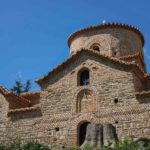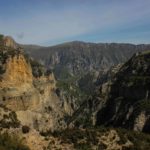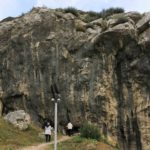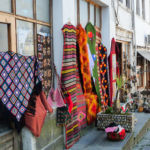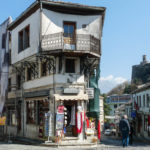Gjirokastër is a city in southern Albania, on a valley between the Gjerë mountains and the Drino, a UNESCO World Heritage Site, described as “a rare example of a well-preserved Ottoman town, built by farmers of large estate”. The city is overlooked by Gjirokastër Fortress, where the Gjirokastër National Folklore Festival is held every five years.
A UNESCO World Heritage Site, Gjirokastra has become famous for best preserving the compactness of an old Ottoman-style city, with a castle overlooking the whole city in the palm of its hand, with old houses resting on the slope of the mountain , each with gorgeous stone facades and wood. As the birthplace of world-renowned Albanian writer Ismail Kadare and the dictator Enver Hoxha, the city is so intriguing and controversial, as it well preserves all stages of history. There is much to see, not only in this unique city, but throughout the region. Very close to Gjirokastra is the beautiful flower town of Përmet, which is crossed by the Vjosa River, the only wild river in Europe. A city full of mysteries is Tepelena, with beautiful history and stunning canyons and waterfalls.
Gjirokastra appears in the historical record dating back in 1336 by its Greek name, Αργυρόκαστρο – Argyrokastro, as part of the Byzantine Empire. It became part of the Orthodox Christian diocese of Dryinoupolis and Argyrokastro after the destruction of nearby Adrianoupolis. Gjirokastër later was contested between the Despotate of Epirus and the Albanian clan of John Zenevisi before falling under Ottoman rule for the next five centuries (1417–1913). Throughout the Ottoman era Gjirokastër was officially known in Ottoman Turkish as Ergiri and also Ergiri Kasrı. Taken by the Hellenic Army during the Balkan Wars of 1912–3 on account of its large Greek population, it was eventually incorporated into the newly independent state of Albania in 1913. This proved highly unpopular with the local Greek population, who rebelled; after several months of guerrilla warfare, the short-lived Autonomous Republic of Northern Epirus was established in 1914 with Gjirokastër as its capital. It was definitively awarded to Albania in 1921. In more recent years, the city witnessed anti-government protests that led to the Albanian civil war of 1997.
Gjirokastër, home to both Albanian and Greek polyphonic singing, is also home to the National Folklore Festival (Albanian: Festivali Folklorik Kombëtar) that is held every five years. The festival started in 1968 and was most recently held in 2009, its ninth season. The festival takes place on the premises of Gjirokastër Fortress. Gjirokastër is also where the Greek language newspaper Laiko Vima is published. Founded in 1945, it was the only Greek-language printed media allowed during the People’s Socialist Republic of Albania.
In recent years, many traditional houses are being reconstructed and owners lured to come back, thus revitalizing tourism as a potential revenue source for the local economy.

